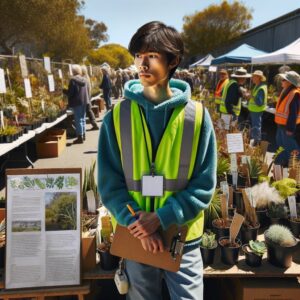Dan Gave Us a Mission We Heartily Accepted
What Happened on the February Field Trip to Silver Steps Falls
by Jo Ann McCracken-Redding
One of the best reasons to take a field trip is the joy of expecting the unexpected. And this hike into the Mountain Bridge Wilderness, led by SCNPS President Dan Whitten, delivered on all fronts!
For starters, we expected rain and packed ponchos, but got perfect weather, with scattered sun rays illuminating our path.
Then, you might expect tree identification to be difficult on February 10th in a mostly leafless forest (unless you’re an experienced naturalist as many in this group are). However, winter is actually an excellent time for tree identification, because as Dan says, “the buds tell the real tale.” And it’s easy to see them in winter.

Blocky bark is unusual for a Black Gum tree of this size.
Photo Credit: Jo Ann McCracken-Redding
He made stops along the trail to point out buds on twigs (the most recent growth) and asked us to note the bud arrangement, also reflected in the branches of the tree.
Examples of the predominant arrangements we identified were the Yellow Birch (Betula alleghaniensis) with alternate buds emerging from the stem one at a time, and the Red Maple (Acer rubrum) with opposite buds.
Another species indicator is bark. We saw blocky bark, sometimes called “alligator bark” on a Black Gum (Nyssa sylvatica), but Dan explained you can’t depend on bark as an identifier because it often changes with age and even exposure to neighboring plants and water.
Dan’s Favorites
Dan spotted an inconspicuous shrub, the Horsesugar (Symplocos tinctoria), and declared, “This is my favorite!” He invited us to chew the leaf like gum, get a sugar boost, spit it out. Probably better to try it in summer and fall when it’s the sweetest. Then he cautions, “This leaf looks a lot like the mountain laurel leaf, which can kill you.” Another good reason to take more field trips and learn your botany!
Then we encountered the Black Birch tree (Betula lenta), also known as Sweet or Cherry Birch. Dan exclaimed, “This is my favorite.” At that point it became clear that many plants on this trail might be THE favorite, and that his passion would make the outdoor class a lot of fun.
One of the reasons the Black Birch is Dan’s favorite is that he loves the wintergreen tea from its twigs and always keeps a pitcher of it at home. Strip the bark off, enjoy inhaling the wintergreen, pour boiling water over the twigs, and steep them. You can use yellow birch, too.
The Mission We Eagerly Accepted Was…
We were nearing Silver Steps Falls, where we planned to have lunch, and then, at a turn in the trail, Dan stopped, looked up at a Sassafras tree (Sassafras albidum), and announced he was on a mission. He’d like our help if we wanted to join in. Who wouldn’t? Climb the tree? Sure, whatever, all in. The field trip’s adventure quotient was ratcheting up.

All hands on tape! It was a group effort to measure this tree.
Photo Credit: Jo Ann McCracken-Redding
The mission was to document a new state champion! Dan’s eye had been on this Sassafras for a while, and he estimated it was taller than the current 49-foot-tall champion in Oconee County.
Then he emptied from his pack a two-foot level, a 100-foot tape measure, and a laser pointer.
To be a state champion, a tree must have the highest number of its species based on trunk circumference, tree height, and average crown spread. Given that Clemson University oversees the champion tree program in South Carolina, they offer a comprehensive guide on their website detailing various tree measurement methods. For those keen on understanding how trees are evaluated for such recognition, a visit to Clemson’s Measuring a Champion Tree page provides valuable insights.
Measurement Teamwork
The tree height measurement applies the rule of triangulation. We were delighted to see the math we learned in high school put to real-world use. Laura Godfrey playfully suggested we call it ‘trigonome-tree’.
A series of measurements were determined with the help of people holding the tape straight and level where the brushy forest made it challenging.
Dan was scribbling measurements in his field notebook while others gathered around eagerly offering to confirm calculations on their phone apps.
The height differential alone gave us confidence: 49 feet for recorded champion and “our” Sassafras at 109 feet! The final score cinched it, we’re leading 178 to 127.

Tree hugging our champion Sassafras (Sassafras albidum).
Photo Credit: Jo Ann McCracken-Redding
When will it be official? Dan will nominate the tree through Clemson. They’ll measure the tree to confirm, and the process may take some time. Meanwhile, we’ll enjoy the thrill of the SCNPS discovery of a champion – thanks to Dan’s eagle eye!
Final Discoveries on the Trail
Although the Sassafras tree stole the show, Silver Steps Falls captivated us with its beauty. We returned by same the same trail stopping to identify more trees and plants such as Mountain Sweet Pepperbush (Clethra acuminata), pagoda dogwood (Swida alternifolia), Shining Clubmoss (Huperzia lucidula), American basswood (Tilia americana), and the herbaceous flowering ghost plant, also known as ghost pipe or Indian pipe (Monotropa uniflora).
At the end of our 4.6-mile round-trip hike, from the height of the last switchback looking down on the parking lot, Dan and Carson Johnson tuned in the quacking of wood frogs. They lead a group that scampered down to find the water where the male frogs were trying to attract females. Some of us had to head back home, okay with missing that last moment of adventure. This trip had already well-exceeded our expectations!











